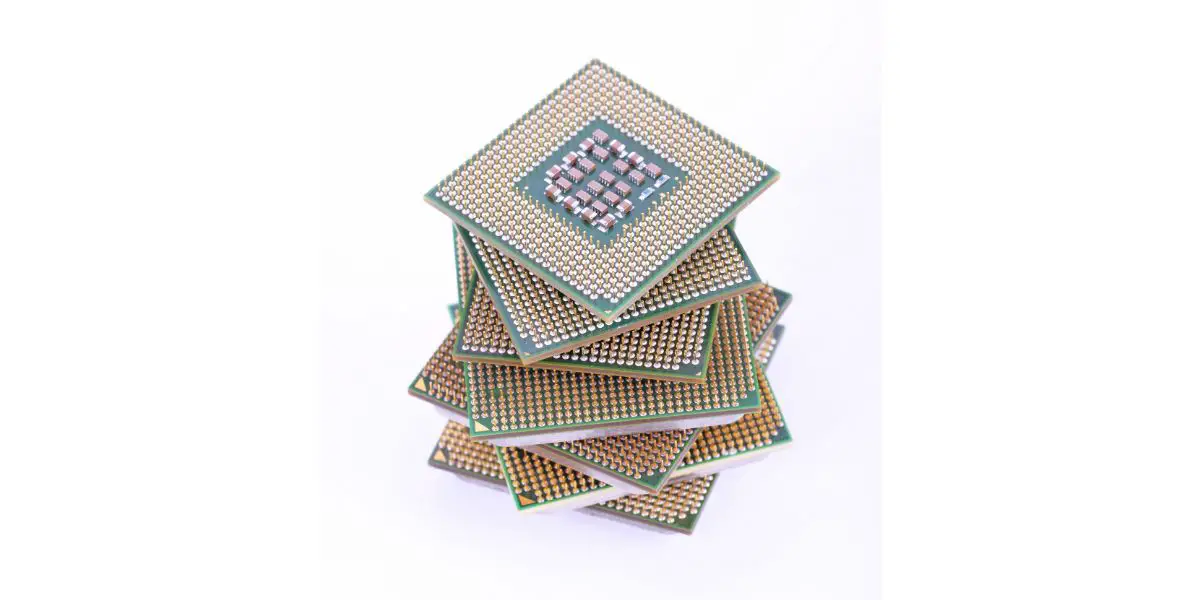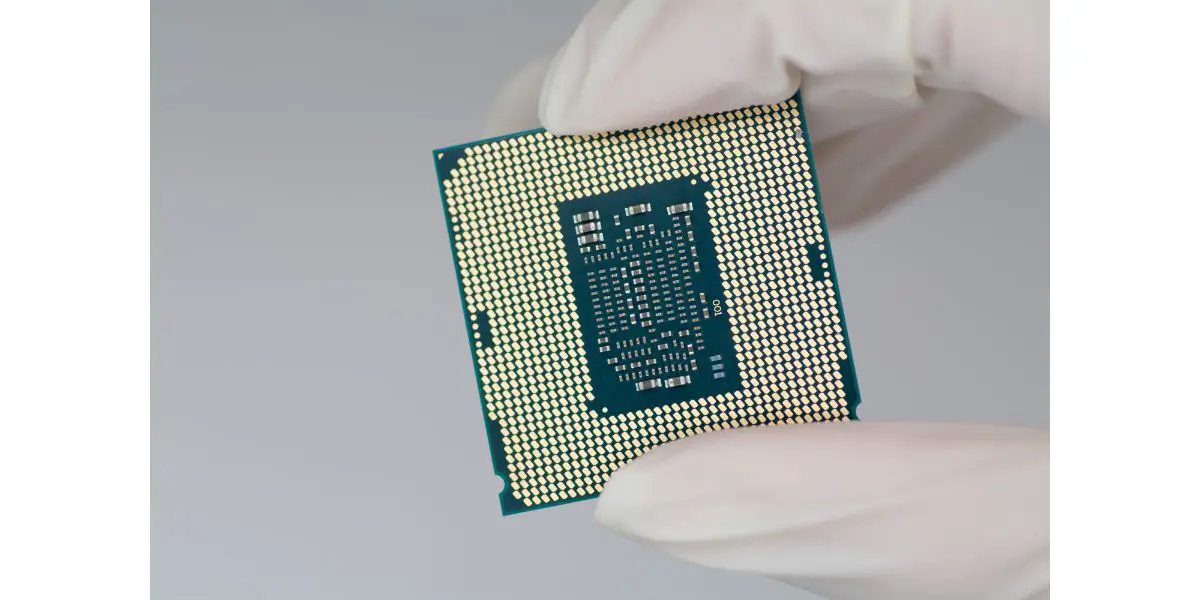Disclaimer: This post may contain affiliate links, meaning we get a small commission if you make a purchase through our links, at no cost to you. For more information, please visit our Disclaimer Page.
The Intel 4004 CPU, introduced in 1971, featured only 2,300 transistors, but the Core CPUs had 560 million by 2010. The Apple M2 Pro processor has 40 billion transistors, and the M2 Max chip has a whopping 67 billion. But why are there so many, and what are they used for?
Table of Contents
How the Number of Transistors Affects CPU Performance
CPUs have many transistors for increasing clock speeds, cores, memory, processing power, and other performance processes.
Desktop PCs or laptops intended for complex computing require efficient and powerful processors, so CPUs must have more transistors to operate as expected. Every input, output, or process involving a CPU requires a few transistors to regulate current or electricity flow.
Most processes use more than one CPU component, so multiple or numerous transistors operate instantaneously to deliver the expected performance.
Thus, the number of transistors determines how quickly a CPU can complete a process. Every task a computer or laptop performs involves multiple instructions and processes, not just your input and the desired output.
Plus, the instructions have to be processed at super-fast speeds. For example, the Intel 4004 CPU with 2,300 transistors could process only 92,600 instructions per second more than 50 years ago.
Some of the earlier Intel Core i9 CPUs can process a few million instructions per second. Such performance needs millions of transistors, if not billions.
All CPUs have 3 broad phases to process anything:
- I-Time: The first phase is known as instruction time. The control unit (CU) or a CPU uses its memory to fetch and interpret the instruction to direct all the relevant data to the ALU or arithmetic logic unit.
- E-Time: The second phase is the execution time when the ALU executes any logical instructions to compute the result. This result is then stored in the cache memory of the CPU, subject to the action of the control unit.
- Machine Cycle: The CU directs the CPU cache to deliver or store the result depending on your input and output instructions. I-Time, E-Time, and the delivery or storage of such a result collectively form the machine cycle.
Every instruction processed by a CPU goes through these 3 phases.
Many processes can have more phases, especially if peripheral devices are involved. Complex processes using sophisticated software or technology can complicate and prolong the instructions.
Not all tasks may be complete with just a one-time processing of instructions, in which case a CPU might have to use another cycle based on its clock speed. Any CPU processing millions to billions of instructions per second require millions to billions of transistors.
Beyond this simple correlation, the varying components of a CPU and their specifications need a certain number of transistors, and the demand has only soared over the years. Let me discuss the major components and the evolution of their specs in the context of CPU transistors.
Architecture
You are probably familiar with the following types of CPU architecture:
- 4-bit
- 8-bit
- 16-bit
- 32-bit
- 64-bit
The old Intel 4004 4-bit CPU could process 4 bits of data simultaneously, while contemporary 64-bit CPUs can process 64 bits simultaneously. You may visualize this architecture as 4-lane and 64-lane highways or sets of 4 and 64 wires conducting electricity simultaneously or not.
CPU transistors serve as switches based on Boolean logic. The binary system, 0 and 1, closes and opens these switches. CPUs also have transistors as amplifiers, but let me use the purpose of switches that form the logic gates.
Since every transistor can open or close, i.e., execute instructions for a process, the difference of bits of data isn’t just 64 – 4 = 60. The difference between 4-bit and 32-bit, and 64-bit isn’t just the varying bits but also what these instructions interact with, which determines a process.
For instance, the bits of data forming an instruction or a process will interact with the control unit and memory. The other key components are the arithmetic logic unit, primary memory (RAM), and storage (hard drive).
Considering the scope of interactions using 0 (close or false) and 1 (open or true), different CPU architectures can access and reference the following quantum of data:
- 4-bit: 24(16 bytes)
- 8-bit: 28 (256 bytes)
- 16-bit: 216 (65,536 bytes)
- 32-bit: 232 (4,294,967,296 bytes, i.e., ~4 GB)
- 64-bit: 264 (18,446,744,073,709,551,616 bytes, i.e., ~18 billion GB)
A 32-bit CPU can theoretically access 4 GB of cache memory, hard drive data, or RAM simultaneously. If a CPU has to interact with 4,294,967,296 memory addresses to complete one or many processes in real-time, it needs plenty of transistors to facilitate such a process.
Most CPUs don’t access all available bytes of data or memory addresses since a lot is already reserved for various system processes. Besides, 18 billion GB or 18 exabytes (EB) for a 64-bit CPU is beyond what any standard desktop computer or laptop needs.
Clock Speed
CPUs have evolved from clock speeds of a few hundred kilohertz to gigahertz. This evolution is directly proportional to the increasing count of transistors in CPUs. Here are a few examples:
- The Intel 4004 4-bit CPU with 23,000 transistors had a clock speed of 740 KHz.
- The iAPX 86 (8086) 16-bit CPU had clock speeds up to 10 MHz with 29,000 transistors.
- The Intel 80286 CPU clocked as high as 25 MHz with 134,000 transistors.
- The first 32-bit Intel CPU (386DX) with 275,000 transistors clocked 16 to 33 MHz.
- All Intel Core i9 CPUs with 5.0 GHz or 5.8 GHz clock speeds have >1 billion transistors.
Clock speed is basically the maximum number of cycles a CPU can complete in a second, so a CPU needs sufficient transistors to initiate, process, and complete those cycles. A CPU with a clock speed of 5 GHz can carry out up to 5 billion cycles per second.
Cores
Like CPU architecture and clock speed, the number of cores has also evolved over time. Every core of a multi-core processor has the main components dedicated or separated from those for the other cores, such as the following:
- ALU (arithmetic logic unit)
- CU (control unit)
- Memory (L1 is dedicated)
Even if cores share the L2 and L3 cache, the key dedicated components are taxing enough to demand millions more transistors, if not billions. Also, multi-core CPUs with hyperthreading require more transistors.
Similarly, overclocking an unlocked CPU will increase the real-time processing demands, so the chip must have many more transistors than locked processors. Every notable improvement in a CPU’s efficiency and performance depends on the transistor count.
Memory
All contemporary CPUs have a substantial cache memory, which is typically split into 3 or even 4 categories in some cases:
- L1
- L2
- L3
- L4
Like all the other main components of CPUs, the cache memory capacity has also expanded in time. The Intel 80386 32-bit CPU had no cache, despite having 275,000 transistors, but modern processors can have 100s of MB of memory (SRAM), including L1, L2, and L3.
Static random access memory (SRAM), which serves as the cache for a core of a CPU, is not the same as dynamic random access memory (DRAM), the primary memory of a PC. DRAM uses 1 transistor per memory cell.
SRAM uses multiple transistors per memory cell, usually 6.
Thus, a CPU with up to 1 GB of cache memory or SRAM needs many more transistors than a conventional RAM or DRAM. SRAM is crucial for performance if your computing requirements depend on cache memory for efficiency or faster turnaround times for all processes.
Processing Capacity
All the main components of a CPU demanding more transistors are essential for greater processing capacity. Transistors are the foundation of any processing metric that you prioritize because all instructions boil down to the following:
- Amplifiers
- Logic gates
- Switches
Consider the example of logic gates:
- AND
- NAND
- NOR
- NOT
- OR
- XNOR
- XOR
Logic gates require 1 to 4 transistors based on the type.
A CPU may have 100 million gates and more, so these logic gates will demand half a billion transistors in contemporary CPUs. Add 200 million transistors per 4 MB of cache, and you will realize why there are so many in a CPU.
Unlike hard drives or storage systems, CPU cache memory is volatile (SRAM), so it doesn’t keep or store data. Many more reads and writes, along with parallel processing, are required to access and interact with the cache memory of a CPU, all of which call for more transistors.
Furthermore, CPUs today have a few transistor-intensive features, such as the following:
- Branch Prediction
- Instruction Set Architecture (ISA)
- Peripherals (i.e., more buses)
- Speculative Multithreading
Each function demands more transistors to be available in real-time to initiate or finish processes, including all kinds of computing instructions within the purview of these specs.
Conclusion
CPUs have many transistors because the amplifiers, gates, and switches are the foundation for a chip or processor’s performance, including efficiency, power consumption, and reliability. A CPU with advanced specs must have more than enough transistors to perform as expected.


